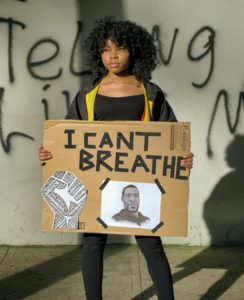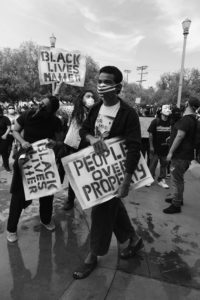This is what the streets of Amsterdam looked like on the first day of the curfew.
door NH Nieuws

Photo Obi Onyeador/Unsplash
The coronavirus has turned our lives upside down. In a matter of weeks, we had to adapt our way of living, placing distance between each other to help stave off the invisible scourge that continues to wage a deadly war on people across the globe. Then, on Tuesday, May 26th, George Floyd – a Black American man – was murdered by a self-righteous Minneapolis police officer, aided by three of his uniformed comrades, while the world watched in horror and disbelief. This time, our world changed in an instant.
While brother Floyd is the latest person to be added to the list of Black citizens to die at the hands, or in this case, the knee of out of control police, it is the graphic nature of how his death was captured and broadcast to the world that has ignited the powder keg of racism commonly referred to as America’s Original Sin. At this moment, we are now witnessing what appears to be a movement, with momentum, conviction, and an uncompromising, unapologetic agenda for ridding the society of the racism and white supremacy that has seemingly infiltrated the DNA of White America.
However, the thousands of peaceful protestors filling the streets of cities throughout the country are unarguably diverse. When White people and Black people march together in solidarity and purpose, we build bridges that are genuine, sincere, trusted, and appreciated. This, hopefully, will be how we evolve to a better state.
The collective pain being experienced by so many here at home and more recently around the entire globe has been thoroughly documented and eloquently expressed. So let me attempt to weave together the two concurrent pandemics that we are doing battle with – Covid-19 and systemic racism – into a way forward that offers a ray of hope.
In response to the coronavirus, many within the design industry have been racing to be out in front of reimagining the world around us in ways that redefine, if not threaten the innate human need for connectivity that we all share. There is no shortage of voices prognosticating the end of society as we knew it, and forecasting a new normal where we all maintain social distancing, never again to shake hands with, or give hugs to the people we would have embraced only a few months ago.
For those with a modicum of privilege, carrying on a lifestyle of separation may be a choice some of us can make. However, many others of lesser means have no such luxury. Both here at home and around the globe, our brothers and sisters who are victims of poverty most often live in places where there is no escaping being bunched-up, shoulder-to-shoulder with family and coworkers. Many rely on mass transit to make it to jobs – jobs that require working in close proximity to others. They cannot escape the harsh consequences of density.
If the killing of George Floyd is truly the tipping point for a collective rejection of centuries-old depravation of a people’s right to equality and equity, then it won’t have been in vain. The fact that people are out in the streets in huge numbers, often unable to observe physical distancing, thereby placing themselves and those around them at greater risk of exposure to the coronavirus, accentuates the power of this moment to initiate meaningful change throughout society.

Photo Mike Von/Unsplash
Back to the immediate response of the design community to develop best practices for altering our physical environment for the benefit of public health, safety, and welfare. I do not mean to discount innovative efforts to solve problems brought about by the pandemic. Quite to the contrary, it is only natural that we move societies forward by allowing the spaces we occupy – public, private, and semi-private – to evolve in response to sensible practices. Our immediate need to isolate and take precautionary measures is indisputable.
I myself fall into the vulnerable class of citizens, given that I’m over 60 and have been a Type 1 (insulin-dependent) diabetic for 43 years. The fear seeded by the lack of clear and responsible leadership at the national level, and further cultivated by the constant barrage of media sensationalism can literally induce paralysis.
The principal question we must confront in the face of this cruel dual pandemic is: how will we, as a country, proceed into the future? With so much division, aided by the politicization of practices that should be evidence-based, we must seek a way forward that elevates truth, science, and knowledge of our history above misguided concerns over infringement on individual rights and the resulting disregard for the health and safety of the majority of us who have opted for safety over selfishness.
Combining these differences of perception with the undeniable revelation of the unfair treatment of Blacks throughout society, in particular by police whose training and indoctrination relied on an old, racist playbook, has seemingly brought us to an acceptance of responsibility and commitment to change. However, charting a definitive course with so many unknowns at this time would be inappropriate. Rather, we should highlight our common goals, as a point of departure for engaging in constructive conversations.
We have the right to:
As humans, we must be willing to walk in each others’ shoes to attain greater understanding of what life is like for all of us in order to take an empathetic path forward to a more perfect society.
As design professionals operating in an increasingly cross-disciplinary way, we have opportunities to collaborate with doctors, healthcare professionals, and scientists on optimizing solutions to stay safe while holding onto the most fundamental aspects of our humanity. In addition, if we claim our role as ‘citizen architects’, we can be at the forefront of mitigating the spatial and environmental disparities between the haves and have-nots that have been laid bare for all to see by this pandemic.
We can and should be leading in what former Brownsville, Texas mayor Tony Martinez characterized as the ‘Great Equalization Project’. It has the potential to set us on a course that history will one day view as the pivotal moment that preserved the greatness of our nation.

Steven Lewis is an American architect who has worked in both government service and private practice. He is now with ZGF Architects, leading the office’s planning and urban design practice. Before that, he was appointed by Detroit Mayor Mike Duggan as Urban Design Director for the central region of the City. For four years he was with the Office of the Chief Architect in Washington, DC. In 2006-’07 he was granted the prestigious Loeb Fellowship at the Harvard Graduate School of Design, where he organized a symposium on race and architecture. In 2009-’11 he was the president of NOMA, the National Organization of Minority Architects.
by Steven Lewis